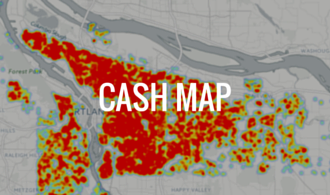Here is the methodology for our reporting on home sales for cash in Multnomah County, Oregon.
InvestigateWest obtained a list of 17,776 cash real estate transactions — the property address and the close of escrow date — occurring between 2006 and 2014 from Oregon Multiple Listing Service. The City of Portland’s Bureau of Technology Services matched 11,236 of the records to property ID numbers.
InvestigateWest matched an additional 3,800 transactions by writing a web crawler, a simple computer program that ran property searches on MultCoPropTax.org, a website maintained by the Multnomah County Department of Assessment & Taxation. The web crawler also downloaded all sales information for each available property ID, including the buyer and seller names, the sale date and price.
We then matched 11,785 cash transactions to the web crawler’s output. For each buyer name, we added up the number of single-family home purchases and total cash spent. Each cash sale was then matched to the next transaction for the property in order to reveal gains on flips and to observe when properties were acquired and how they were next sold. Overall cash activity was summarized by zip code and month.
This data was contextualized within the larger cash marketplace with help from RealtyTrac, the real estate information company. RealtyTrac provided data on overall cash transactions in Portland, Vancouver, Beaverton and Multnomah County, as well as data detailing foreclosure and auction activity, affordability for buyers and total cash purchases in the listed, auction, and private contract marketplace. The company also provided data on institutional investor sales and on how many cash purchases were later financed.
Reporters researched available data, institutional buyers and conducted more than 40 interviews with traditionally financed home buyers, real estate agents, title company officials, bankers, policymakers and researchers with expertise in institutional investment. A reporter also interviewed those institutional buyers listed in this story who agreed to be interviewed, and the organizations supplying data.
In some cases, research was required to parse the corporate ownership of the 26 companies most listed on property documents.
A reporter combined online research with research of the Oregon Secretary of State’s records, Oregon Construction Contractors Board licenses, and review of U.S. Securities and Exchange Commission filings to identify corporate owners. TLO.xp, an investigative data service, was used to obtain emails and phone numbers for owners that proved difficult to reach.
Efforts were made to contact all of the 26 institutional investors identified. Most received phone calls and direct invitations to interview. Others also received emails. In two cases where contact information for investors proved elusive, messages were left with the colleagues of those investors.
Many did respond to phone calls and emails and were interviewed for this article, providing valuable insights into the marketplace. Others did not return calls or emails, or missed appointments to be interviewed. Two investors that indicated a willingness to speak could not be effectively reached before the date of publication.






